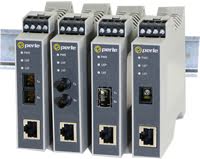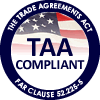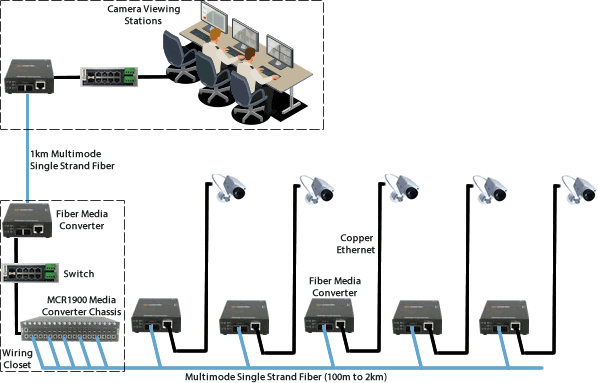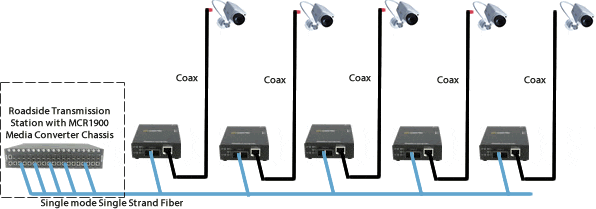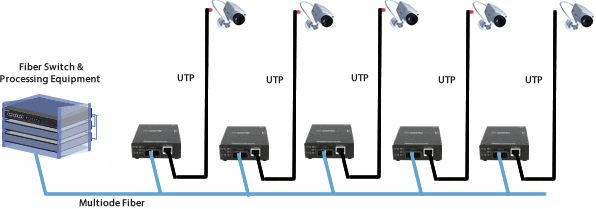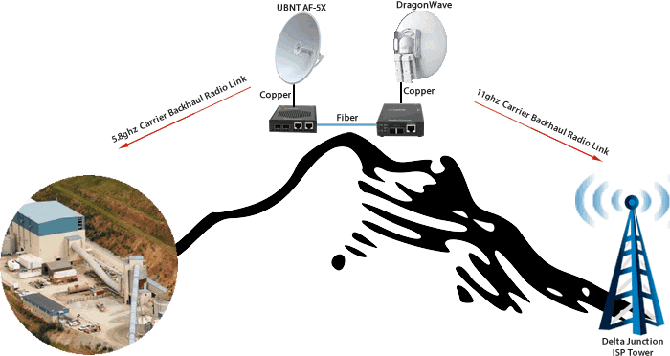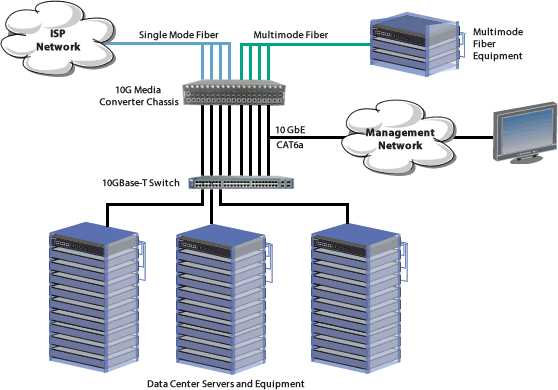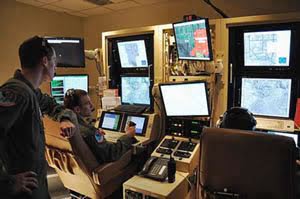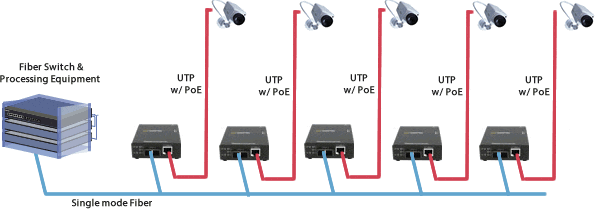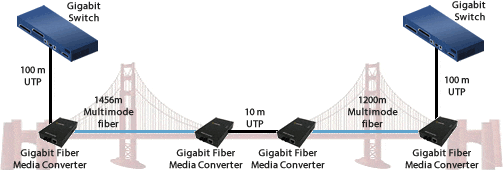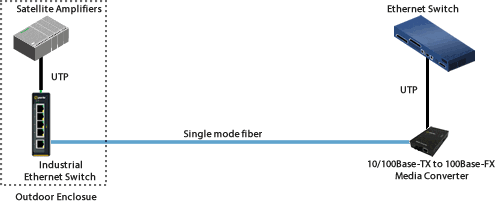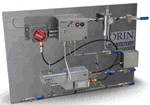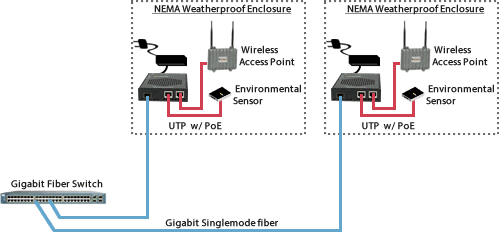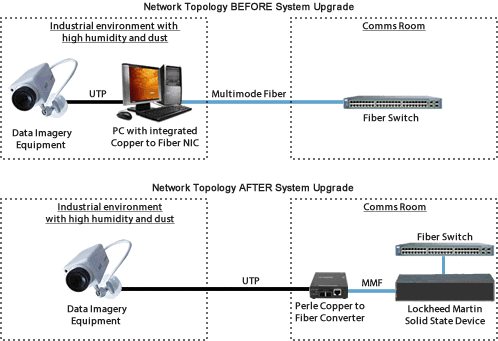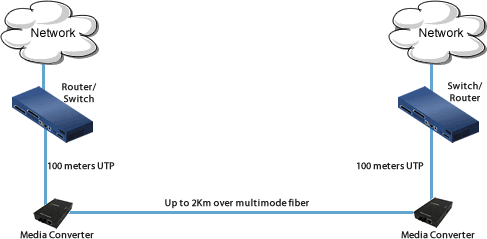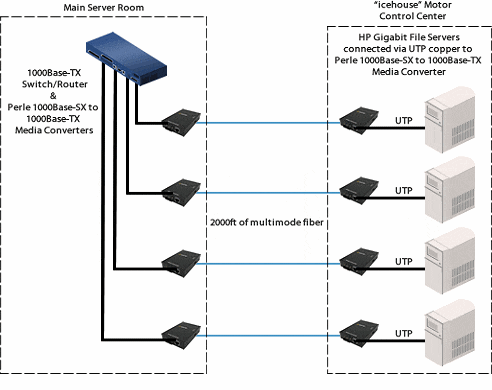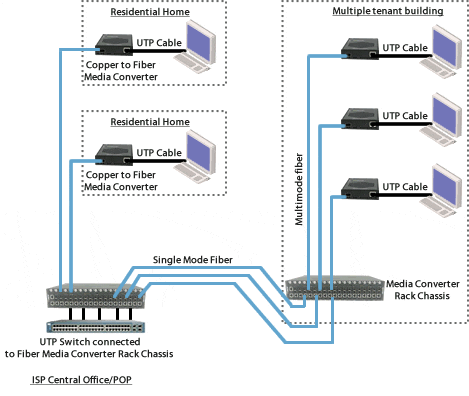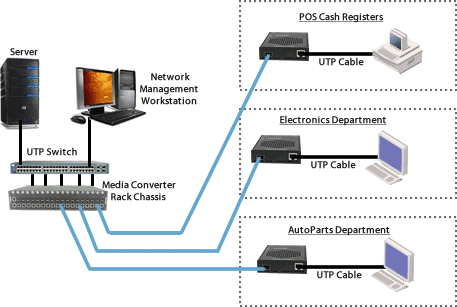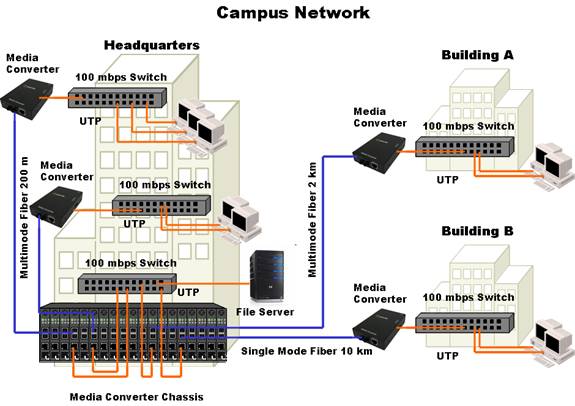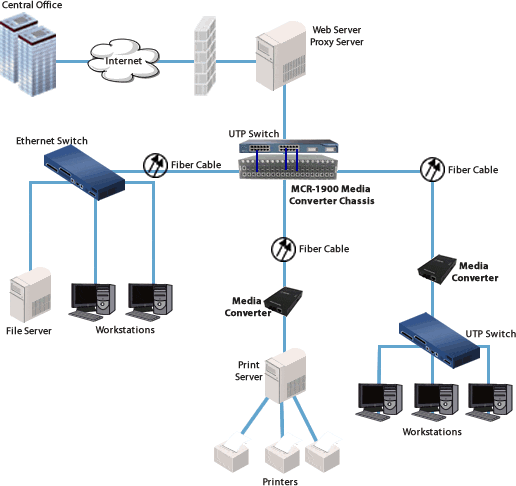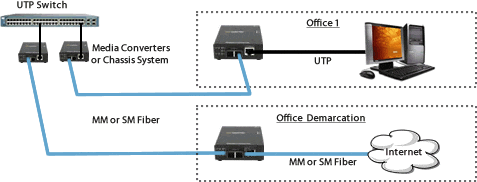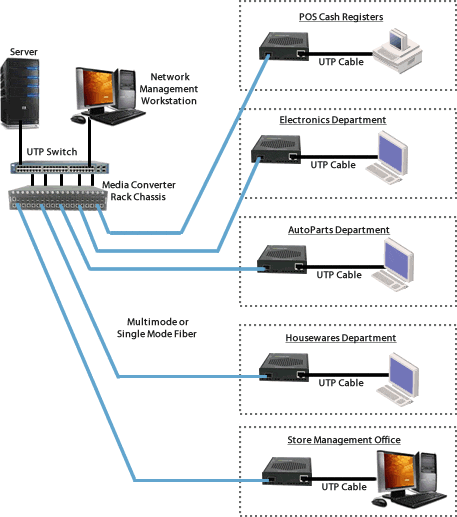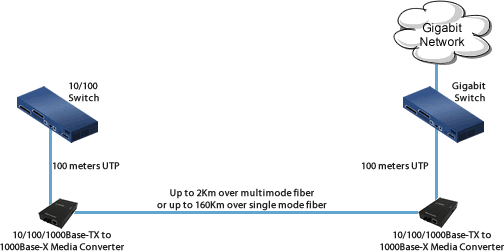SR-1000 Medienkonverter für die Hutschiene
Gigabit Kupfer zu LWL Konverter
- 1000Base-T zu 1000Base-X LWL Medienkonverter
- Verbinden Kupfer mit Multimode oder Single-Mode LWL
- Zweiader-LWL-ST/SC- oder Einader-LWL-SC-Anschlüsse
- Netzwerkdistanzen bis zu 160 km
- Features: Link-Pass-Through, Far-End Fault, Auto-MDIX
- Dreifacher Spannungseingang: Stromanschluss mit 2 x Anschlussblöcken und T-Bus
Perle SR-1000 Industrielle Medienkonverter für die Hutschiene, verbinden UTP Kupfer mit LWL auf transparente Weise. Diese Gigabit-Medienkonverter stellen einen wirtschaftlichen Weg dar, um:
- Gigabit-Geschwindigkeiten über einen Multimode-LWL-Link von bis zu 2 km Länge zu ermöglichen (mehr hierzu erfahren)
- Distanzen eines vorhandenen Netzwerks zu erweitern, durch CAT5/6/7-Verkabelung mit Multimode oder Single-Mode-LWL Verbindung
- Lebensdauer Verlängerung von nicht-LWL-basierten Geräten durch Ermöglichung einer Datenübertragung von 1000Base-T-Geräten über Gigabit-LWL
- Distanzen zwischen zwei kupferbasierten Geräten oder Netzwerken zu erweitern
- Ethernet-Daten vor EMI-Störungen und Interferenzen zu schützen, indem Sie in Industrieanlagen Ihre Kupfer-Ethernet-Geräte über LWL miteinander verbinden
Einige SR-1000 Medienkonverter sind auch mit SFP-Steckplatz oder mit Unterstützung von erweiterten Betriebstemperaturen von -40°C bis 75°C erhältlich.
Netzwerkadministratoren können sich auf Perle Features verlassen, zum Beispiel Autonegotiation, Auto-MDIX, Link-Pass-Through, Far-End Fault und Pause, die die Verbindungen von Endpunkt zu Endpunkt vollständig transparent machen. Diese Kosten und Zeit sparenden Funktionen sowie eine lebenslange Gewährleistung und kostenloser technischer Support weltweit machen die SR-1000 Gigabit Medienkonverter zur besten Wahl für IT-Profis.
Features der SR-1000 LWL-Medienkonverter 1000Base-T zu 1000Base-X
| Hutschienen-Gehäuse | Einfache Montage auf einer Hutschiene oder in Verteilerschränken mithilfe eines nativen Hutschienengehäuses mit Erdungsclip. Keine Notwendigkeit für zusätzliche Klammern. |
| Auto-Negotiation | Der Medienkonverter unterstützt Autonegotiation. Die 1000Base-X-Schnittstelle verhandelt gemäß 802.3 Klausel 37. Die 1000Base-T-Schnittstelle verhandelt gemäß 802.3 Klausel 28 und 40. Die 1000Base-X-Schnittstelle stellt eine Verbindung zum Partner her, wenn der höchste gemeinsame Denominator (HCD) erreicht ist und das Kupferkabel eine Verbindung zum Partner hergestellt hat. Die 1000Base-X-Schnittstelle durchläuft die Negotiation und übermittelt dabei den Remote-Offline-Fehler (sofern dies über die Switch-Einstellung aktiviert ist), bis das Kupferkabel-Uplink hergestellt wurde und die HCDs übereinstimmen. Der LWL Medienkonverter unterstützt Auto-Negotiation von Full-Duplex, Half-Duplex, Remote Fault, Full Duplex Pause, Asymetric Pause und Auto MDI-X. |
| Auto-MDIX mit Skew-Korrektur | Auto-MDIX (Automatic Medium-Dependant Interface Crossover) erkennt die Signale an der 1000Base-T-Schnittstelle, um zu bestimmen, welcher Kabeltyp angeschlossen ist (Straight-Through oder Crossover) und konfiguriert die Verbindung automatisch, wenn diese Funktion aktiviert ist. Der Medienkonverter kann auch Leitungen ausgleichen, die in einem Paar ausgetauscht wurden. Der Medienkonverter kann bis zu 64 ns Verzögerungs-Skew zwischen den 1000Base-T ausgleichen. |
| Smart Link Pass-Through | Wenn der Smart Link-Pass-Through-Modus aktiviert ist, gibt der Kupfer Ethernet Port den Status des Ethernet LWL Medienkonverterports wieder. Die Verwendung dieser Funktion ist unabhängig davon, ob die LWL-Auto-Negotiation aktiviert oder deaktiviert ist. |
| Fiber Fault Alert | Mit dem Fiber Fault Alert wird der Status des 1000Base-X-Receivers an den 1000Base-X-Transmitter übergeben. So wird das an die 1000Base-X-Schnittstelle des Medienkonverters angeschlossene Partnergerät über den Fehler benachrichtigt. Wenn der 1000Base-X-Transmitter als Folge dieses Fehler ausgeschaltet ist, wird er in regelmäßigen Abständen eingeschaltet, damit der Fehlerzustand behoben werden kann, falls das Partnergerät an der 1000Base-X-Schnittstelle eine ähnliche Technik verwendet. Auf diese Weise werden Lockouts verhindert, die bei einigen Medienkonvertern auftreten. Gilt nur, wenn die LWL-Autonegotiation deaktiviert ist. |
| Pause (IEEE 802.3x) | Pause-Signalisierung ist eine IEEE-Funktion, die die Datenübertragung zwischen zwei Geräten zeitweilig aussetzt, falls eines der Geräte überlastet ist. Der Fast-Ethernet-Medienkonverter unterstützt die Pause-Negotiation für die 1000Base-T-Kupfer-Verbindung und die 1000Base-X-LWL-Verbindung. |
| Duplex | Es werden Voll- und Halbduplexbetrieb unterstützt. |
| Jumbo-Pakete | Transparent für Jumbo-Pakete bis 10 KB. |
| VLAN | Für VLAN-getaggte Pakete transparent. |
| Remote LoopBack | An der 1000Base-X-LWL-schnittstelle kann ein Loopback ausgeführt werden. |
Specifications
HTSUS Number:
8517.62.0020
UNSPSC Code:
43201553
ECCN:
5A991
Power
Input Supply Voltage
Triple voltage 12 / 24 / 48 VDC (9.6 – 60 VDC) input supporting:
- 2 x Terminal Block power input and
- 1 x T-Bus power input
Current
0.09 A (@ 24VDC)
Power Consumption
2.16 watts (@ 24VDC)
Power Connector
Dual input Terminal Block and/or T-Bus
Indicators
Power / TST
This green LED is turned on when power is applied to the media converter. Otherwise it is off. The LED will blink fast/slow when in Loopback test mode or hardware error.
Fiber link on / Receive activity (LKF)
- On: Fiber link present.
- Blinking slowly: Fiber link disabled because of copper link loss.
- Blinking quickly: Fiber link present and receiving data.
- Off: No fiber link present
Copper link on / Receive activity (LKC)
- On: Fiber link present.
- Blinking slowly: Fiber link disabled because of copper link loss.
- Blinking quickly: Fiber link present and receiving data.
- Off: No fiber link present
Switches - accessible by sliding the chassis open

Auto-Negotiation
Auto (Default-Up): In this mode of operation the media converter will negotiate Ethernet parameters on both the copper and the fiber connection. This will ensure the most optimal connection parameters will be in effect. If connecting to another Perle Gigabit Media Converter, this parameter should be set to Auto.
Off: The fiber Negotiation should only be turned off, if the fiber link partner does not support fiber link negotiations
Standard Mode (Default-Up): In this mode, if Fiber Negotiation is set to OFF, the links on the fiber and copper sides can be brought up and down independently of each other. A loss of link on either the fiber link or copper link can take place without affecting the other connection. However, if the Fiber Negotiation (switch 2) is set to Auto, then a loss of link on the copper side will result in a loss of link on the fiber side but not vice versa.
Smart Link Pass-Through (Down): In this mode, the link state on one connection is directly reflected through the media converter to the other connection. If link is lost on one of the connections, then the other link will be brought down by the media converter.
Pause
Enabled (Default-Up): In this mode, when Fiber Negotiation has been turned off, the media converter will use this setting for its Ethernet parameter negotiation on the copper connection. With this Pause switch in the Enabled position, the media converter will advertise support for Symmetrical and Asymmetrical Pause.
Disabled: The media converter will not advertise support for the Pause feature.
Loopback
Disabled (Default-Up): The loopback feature is disabled. This is the normal position for regular operation. The switch must be set to this position for data to pass through the media converter.
Enabled: This is a test mode. All data received on the receive (RX) fiber connection is looped back to the transmit (TX) fiber connection. The state of the copper is not relevant and no data or link status is passed through to the copper side.
Fiber Fault Alert (FFA)
Enabled (Default-Up): In this mode, when Fiber negotiation is turned on, if the media converter detects a loss of fiber signal on the fiber receiver it will immediately disable its fiber transmitter signal. This notifies the fiber link partner that an error condition exists on the fiber connection. If the remote media converter is set up for FFA Enabled and the local media converter is set up with Smart Link Pass-Through, a loss of fiber link on either the transmit or receive line will be passed through to the local copper connection to notify the connected device. If the media converter has been set to Smart Link Pass-Through mode, the effect will be the same as FFA since the link loss on the fiber receiver will result in bringing down the copper link, which will in turn cause the transmit fiber link to be brought down.
Disabled: In this mode, the media converter will not monitor for fiber fault.
Duplex Mode
Auto (Default-Up): In this mode, when Fiber Negotiation has been turned off, the media converter will use this Duplex setting for its Ethernet parameter negotiation on the copper connection. In the Auto position, the media converter will advertise support for both Full and Half Duplex mode. The resultant negotiation will provide the most optimum connection.
Half: In this mode, the media converter will force the negotiation to Half Duplex mode
Cables and Connectors
1000Base-T
RJ45 connector, 4 pair CAT 5 (UTP or STP) or better cable
Fixed Fiber
- Dual multimode or single mode ( Duplex ) fiber - SC, ST
- Single strand fiber ( Simplex ) – SC
Magnetic Isolation
1.5kv
Fiber Optic Cable
- Multimode: 62.5 / 125, 50/125, 85/125, 100/140 micron
- Single Mode: 9/125 micron (ITu-T 625)
Filtering
Filtering
1024 MAC Addresses
Frame Specifications
Buffer
512 Kbits frame buffer memory
Size
Maximum frame size of 10,240 bytes
Packet Transmission Characteristics
Bit Error Rate (BER)
<10 -12
Environmental Specifications
Operating Temperature
-10°C to 60°C (14°F to 140°F)
Storage Temperature
-25°C to 70°C (-13°F to 158°F)
Operating Humidity
5% to 90% non-condensing
Storage Humidity
5% to 95% non-condensing
Operating Altitude
Up to 3,048 meters (10,000 feet)
Heat Output (BTU/HR)
7.37
MTBF (Hours)*
695,274 Hours
Calculation model based on MIL-HDBK-217-FN2 @ 30°C
Chassis
Molded plastic DIN Rail case with an IP20 ingress protection rating
Mounting
Din Rail Kit
Native
Product Weight and Dimensions
Weight
0.12 kg, 0.26 lbs
Dimensions
114 x 100 x 22.5mm, 4.5 x 3.9 x 0.88 inches
Packaging
Shipping Weight
0.17 kg, 0.37 lbs
Shipping Dimensions
145 x 105 x 30 mm, 5.7 x 4.1 x 1.2 inches
Regulatory Approvals
Emissions
- FCC 47 Part 15 Class A
- EN55011 (CISPR11)
- ICES-003
- EN61000-6-4 (Emissions for industrial environments)
- CISPR 32 / EN 55032
- EN61000-3-2
Immunity
- CISPR 35 / EN 55035
- EN 61000-4-2 (ESD)
- EN 61000-4-3 (RS)
- EN 61000-4-4 (EFT)
- EN 61000-4-5 (Surge)
- EN 61000-4-6 (CS)
- EN 61000-4-8 (PFMF)
- EN 61000-4-11
- IEC/EN 61000-6-2 (General Immunity for Industrial Environments)
Safety
- UL/EN/IEC 62368-1 (previously 60950-1)
- CAN/CSA C22.2 No. 62368-1
- CE
Laser Safety
- EN 60825-1
- Fiber optic transmitters on this device meet Class 1 Laser safety requirements per IEC-60825 FDA/CDRH standards and comply with 21CFR1040.10 and 21CFR1040.11.
Select a Model to obtain a Part Number - SR-1000 DIN Rail Media Converters
Dual Fiber Models
| Model | Connector | Type | Transmit (dBm) | Receive (dBm) | Power Budget (dBm) | Wavelength (nm) | Fiber Type | Core Size (um) | Modal Bandwidth (MHz* Km) | Operating Distance | ||
|---|---|---|---|---|---|---|---|---|---|---|---|---|
| Min | Max | Min | Max | |||||||||
| SR-1000-SC05 | Dual SC | 1000Base-SX | -9.5 | -4.0 | -17.0 | -3.0 | 7.5 | 850 | MMF | 62.5 | 160 | 220 m (722 ft) |
62.5 | 200 | 275 m (902 ft) | ||||||||||
50 | 400 | 500 m (1,640 ft) | ||||||||||
50 | 500 | 550 m (1,804 ft) | ||||||||||
50 | 2000 | 1000 m (3281 ft) | ||||||||||
| SR-1000-ST05 | Dual ST | 1000Base-SX | -9.5 | -4.0 | -17.0 | -3.0 | 7.5 | 850 | MMF | 62.5 | 160 | 220 m (722 ft) |
62.5 | 200 | 275 m (902 ft) | ||||||||||
50 | 400 | 500 m (1,640 ft) | ||||||||||
50 | 500 | 550 m (1,804 ft) | ||||||||||
50 | 2000 | 1000 m (3281 ft) | ||||||||||
| SR-1000-SC2 | Dual SC | 1000Base-LX | -6.0 | 0.0 | -17.0 | -0.0 | 11 | 1310 | MMF | 62.5 | 160 | 2 km (1.2 mi) |
50 | 500 | 1000m (3280 ft) | ||||||||||
| SR-1000-ST2 | Dual ST | 1000Base-LX | -6.0 | 0.0 | -17.0 | -0.0 | 11 | 1310 | MMF | 62.5 | 160 | 2 km (1.2 mi) |
50 | 500 | 1000m (3280 ft) | ||||||||||
| SR-1000-SC10 | Dual SC | 1000Base-LX/LH | -9.5 | -3.0 | -20.0 | -3.0 | 10.5 | 1310 | MMF* | 62.5 | 500 | 550 m (1804 ft) |
50 | 400 | 550 m (1,804 ft) | ||||||||||
50 | 500 | 550 m (1,804 ft) | ||||||||||
SMF | ** | - | 10 km (6.2 mi) | |||||||||
| SR-1000-ST10 | Dual ST | 1000Base-LX/LH | -9.5 | -3.0 | -20.0 | -3.0 | 10.5 | 1310 | MMF* | 62.5 | 500 | 550 m (1804 ft) |
50 | 400 | 550 m (1,804 ft) | ||||||||||
50 | 500 | 550 m (1,804 ft) | ||||||||||
SMF | ** | - | 10 km (6.2 mi) | |||||||||
| SR-1000-SC40 | Dual SC | 1000Base-EX | -2.0 | 2.0 | -23.0 | -3.0 | 21.0 | 1310 | SMF | ** | - | 40 km (25 mi) |
| SR-1000-ST40 | Dual ST | 1000Base-EX | -2.0 | 2.0 | -23.0 | -3.0 | 21.0 | 1310 | SMF | ** | - | 40 km (25 mi) |
| SR-1000-SC70 | Dual SC | 1000Base-ZX | -2.0 | 5.0 | -23.0 | -3.0 | 21.0 | 1550 | SMF | - | - | 70 km (43 mi) |
| SR-1000-ST70 | Dual ST | 1000Base-ZX | -2.0 | 5.0 | -23.0 | -3.0 | 21.0 | 1550 | SMF | - | - | 70 km (43 mi) |
| SR-1000-SC120 | Dual SC | 1000Base-ZX | 0.0 | 5.0 | -32.0 | -9.0 | 32 | 1550 | SMF | - | - | 120 km (75 mi) |
| SR-1000-ST120 | Dual ST | 1000Base-ZX | 0.0 | 5.0 | -32.0 | -9.0 | 32 | 1550 | SMF | - | - | 120 km (75 mi) |
| SR-1000-SC160 | Dual SC | 1000Base-ZX | 2.0 | 5.0 | -34.0 | -9.0 | 36 | 1550 | SMF | - | - | 160 km (100 mi) |
| SR-1000-ST160 | Dual ST | 1000Base-ZX | 2.0 | 5.0 | -34.0 | -9.0 | 36 | 1550 | SMF | - | - | 160 km (100 mi) |
Single Fiber Models Recommended use in pairs
| Model | Connector | Type | Transmit (dBm) | Receive (dBm) | Power Budget (dBm) | Wavelength (nm) | Fiber Type | Core Size (um) | Modal Bandwidth (MHz* Km) | Operating Distance | ||
|---|---|---|---|---|---|---|---|---|---|---|---|---|
| Min | Max | Min | Max | |||||||||
| SR-1000-SC05U | Single SC | 1000Base-BX-U | -10.0 | -4.0 | -17.0 | -3.0 | 7.0 | 1310 / 1550 | MMF | 62.5 | 500 | 500 m (1,640 ft) |
50 | 500 | 500m 1,640 ft) | ||||||||||
| SR-1000-SC05D | Single SC | 1000Base-BX-D | -10.0 | -4.0 | -17.0 | -3.0 | 7.0 | 1550 / 1310 | MMF | 62.5 | 500 | 500 m (1,640 ft) |
50 | 500 | 500m 1,640 ft) | ||||||||||
| SR-1000-SC10U- | Single SC | 1000Base-BX-U | -9.0 | -3.0 | -20.0 | -3.0 | 11.0 | 1310 / 1490 | SMF | ** | - | 10 km (6.2 mi) |
| SR-1000-SC10D | Single SC | 1000Base-BX-D | -9.0 | -3.0 | -20.0 | -3.0 | 11.0 | 1490 / 1310 | SMF | ** | - | 10 km (6.2 mi) |
| SR-1000-SC20U | Single SC | 1000Base-BX-U | -8.0 | -3.0 | -22.0 | -3.0 | 14.0 | 1310 / 1490 | SMF | ** | - | 20 km (12.4 mi) |
| SR-1000-SC20D | Single SC | 1000Base-BX-D | -8.0 | -3.0 | -22.0 | -3.0 | 14.0 | 1490 / 1310 | SMF | ** | - | 20 km (12.4 mi) |
| SR-1000-SC40U | Single SC | 1000Base-BX-U | -3.0 | 2.0 | -23.0 | -3.0 | 20.0 | 1310 / 1490 | SMF | ** | - | 40 km (25 mi) |
| SR-1000-SC40D | Single SC | 1000Base-BX-D | -3.0 | 2.0 | -23.0 | -3.0 | 20.0 | 1490 / 1310 | SMF | ** | - | 40 km (25 mi) |
| SR-1000-SC80U | Single SC | 1000Base-BX-U | -2.0 | 3.0 | -26.0 | -3.0 | 24.0 | 1510 / 1590 | SMF | - | - | 80 km (50 mi) |
| SR-1000-SC80D | Single SC | 1000Base-BX-D | -2.0 | 3.0 | -26.0 | -3.0 | 24.0 | 1590 / 1510 | SMF | - | - | 80 km (50 mi) |
| SR-1000-SC120U | Single SC | 1000Base-BX-U | -3.0 | 2.0 | -34.0 | -9.0 | 31 | 1510 / 1590 | SMF | - | - | 120 km (75 mi) |
| SR-1000-SC120D | Single SC | 1000Base-BX-D | -3.0 | 2.0 | -34.0 | -9.0 | 31 | 1590 / 1510 | SMF | - | - | 120 km (75 mi) |
*A mode-conditioning adapter as specified by the IEEE standard, is required regardless of the span length. Note how the mode conditioning adapter for 62.5-um fibers has a different specification from the mode-conditioning adapter for 50-um fibers.
**ITU-T G.652 SMF as specified by the IEEE 802.3z standard.
Application Diagrams
Distanz zwischen zwei UTP Gigabit Switches vergrössern
Netzwerkdistanz zwischen zwei Twisted Pair Gigabit Switches vergrößern
Zwei Gigabit Ethernet LWL Medienkonverter können die Distanz zwischen 1000Base-T-Switches über eine LWL-Verbindung auf bis zu 160 km Länge vergrößern.
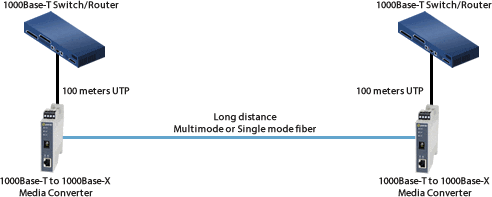
Gigabit UTP Switch zu LWL Switch
UTP-Switch mit einem LWL Switch verbinden
Ein Medienkonverter kann einen kupferbasierten UTP-Switchport mit einem Remote-Switch mit integriertem LWL verbinden.
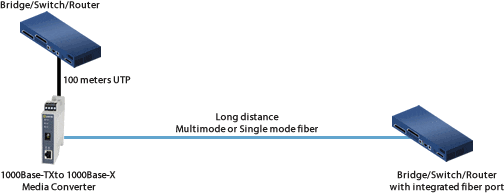
Switch zu Gigabit Server
Netzwerkdistanz zwischen einem Gigabit-Switch und einem Gigabit-File Server vergrößern
Zwei Gigabit Ethernet LWL Medienkonverter können die Distanz zwischen einem 1000Base-T-Switch und einem Gigabit-File Server über eine LWL-Verbindung auf bis zu 160 km Länge vergrößern.
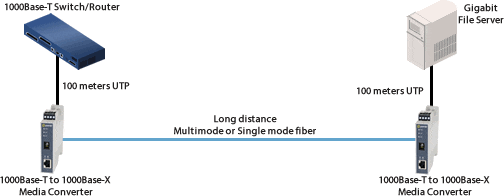
Direct Connect - Direkte Verbindung - weite Distanz
Direkte Verbindung zwischen zwei Remotegeräten
Mit einem Paar Fast Ethernet LWL Medienkonvertern können zwei Geräte, z. B. File Server, über eine LWL-Verbindung mit einem Remote-File Server in bis zu 160 km Entfernung verbunden werden.
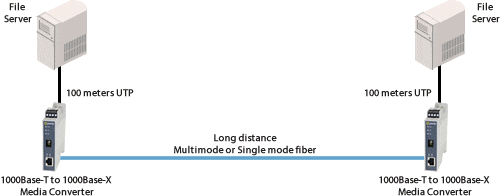
Gigabit Modus-Conditioning Adapter - Mehr Distanz
Gigabit über 62,5-Mikron-MMF auf 550 m vergrößern
Gigabit über 62,5-Mikron-MMF-Kabel ist normalerweise auf 275 m beschränkt. Mit Mode-Conditioning-Kabeln und 1000BaseLX-LWL Medienkonvertern können Sie diese Entfernung auf bis zu 500 m über MMF vergrößern.
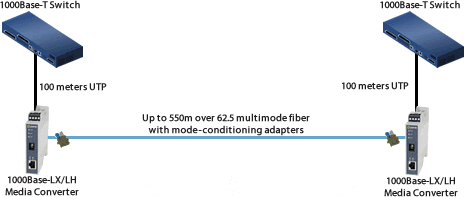
Gigabit Modus-Conditioning Adapter – 1000Base-LX
Installation von Gigabit 1000Base-LX Routern und Switches in bestehende Multimode-Kabelanlagen
Verbinden Sie einen kupferbasierten Gigabit-Switch mit einem Remote 1000base-LX-Switch / Router über eine bestehende Multimode-Kabelanlage, indem Sie Adapter für die Moduskonditionierung und einen 1000Base-LX-Medienkonverter verwenden.
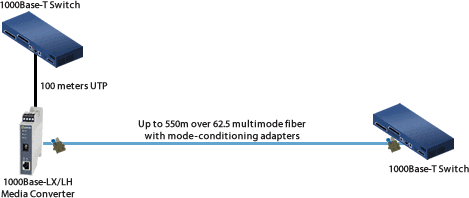
Gigabit zu IP-Kameras
Verbindung von IP-Kameras mit dem Gigabit-Backbone
Erweiterung der Reichweite zu IP Kameras mit industriellen LWL Medienkonvertern.
Stand-Alone erweiterte Temperatur-Medienkonverter werden am entfernten Ende aufgestellt, die Kameras mit Kupferschnittstellen zur Glasfaserverkabelung verbinden. LWL kann den Abstand mit einer Single Mode oder Multimode LWL bis zu 160 km zurück zu einem Kontrollzentrum erweitern. Ein Medienkonverterchassis, das sich im Datenschrank im Kontrollzentrum befindet, akzeptiert das LWL Signal, wandelt es um und stellt eine Verbindung zur Kupferausrüstung am Hauptstandort her.
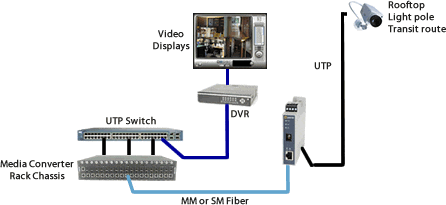
Gigabit LWL zu Wireless Access Points
Verbindung von Wireless Access Points mit dem Gigabit-Backbone
Erweitern Sie die Reichweite zu WLAN Access Points (WAP) unter Verwendung von LWL Medienkonvertern. Verwendet ein Unternehmen ein WLAN in seinem Büro oder großen Lagerraum, müssen in der gesamten Anlage WAPs eingerichtet werden, um für Zuverlässigkeit eine vollständige Abdeckung sicherzustellen. Der Netzwerkbetreuer muss die 100 zulässigen Meter durch Kupferkabel weiter ausdehnen, um viele der WAPs zu erreichen.
Die WAPs werden in industriellen Umgebungen verwendet, in denen hohe oder/und niedrige Temperaturen ein Problem darstellen; Stand-Alone Industrielle Medienkonverter werden am entfernten Ende aufgestellt und APs werden mit Kupferschnittstellen zur Glasfaserverkabelung aufgestellt. LWL kann den Abstand mit einer Single Mode oder Multimode LWL bis zu 160 km zurück zu einem Kontrollzentrum erweitern. Ein Medienkonverterchassis, das sich im Datenschrank im Kontrollzentrum befindet, akzeptiert das LWL Signal, wandelt es um und stellt eine Verbindung zur Kupferausrüstung am Hauptstandort her.
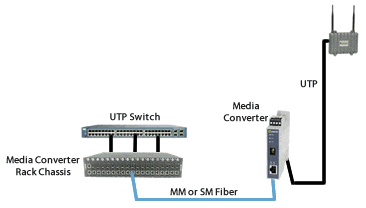
Enterprise Infrastruktur
Unternehmensinfrastruktur mit LWL
Schaffen Sie eine LWL Infrastruktur für Ihr Unternehmensnetzwerk, ohne dass Sie vorhandene kupferbasierte Einrichtungen komplett austauschen müssen.
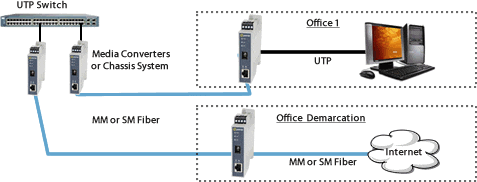
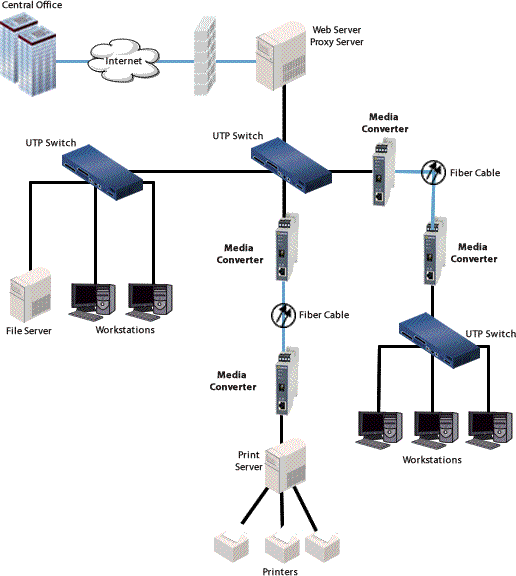
Single Mode / Single Fiber
Verbindung von Kupferports über ein Single Fiber Strand oder Einfaserkabel (sog. "bidirektionale" Verbindung)
Wenn Single Fiber kabel verwendet werden, werden für die Kupfer zu LWL Konvertierung zwei Single Fiber Medienkonverter benötigt. Single Fiber Medienkonverter von Perle werden auch als “Upstream/Downstream”-Modelle bezeichnet. Der unten abgebildete SR-1000-SC05U (“Upstream”) und der SR-1000-SC05D (“Downstream”) müssen z. B. paarweise verwendet werden. Ein “Upstream”-Modell muss mit einem “Downstream”-Peer kombiniert werden, damit die Sende- und Empfangsfrequenzen getrennt gehandhabt werden können.
 SR-1000-SC05USR-1000-SC05D
SR-1000-SC05USR-1000-SC05D
Die meisten installierten Singlemode LWL Medienkonverter sind vom "Dual-Stecker" oder "Dual-LWL"-Typ, wobei eine LWL / Glasfaserverbindung zum Senden und die andere zum Empfangen verwendet wird. Sie werden physisch "gekreuzt", um eine Sende-/Empfangsverbindung zu erhalten
Um die Kosten zu reduzieren, oder falls es nicht genügend LWL Leitungen gibt, kann die WDM-Technologie eingesetzt werden. WDM verwendet getrennte Sende- und Empfangsfrequenzen für die Kommunikation über Single Fiber Strand. Die WDM-Technologie nutzt die Tatsache, dass LWL viele Wellenlängen gleichzeitig übertragen können, ohne dass es zu einer Interaktion zwischen den einzelnen Wellenlängen kommt. Daher kann eine einzige LWL viele getrennte Wellenlängen-Signale oder Kanäle gleichzeitig übertragen.
Denken Sie also daran, wenn Single Fiber Kabel verwendet werden, benötigen Sie für die Kupfer zu LWL Konvertierung einen “Upstream”-Medienkonverter auf der einen und einen “Dowstream”-Medienkonverter auf der anderen Seite.
Perle verfügt über eine breite Palette von Single Fiber Srand Medienkonvertern (“Upstream/Downstream”) für den Anschluss von 10BaseT, Fast Ethernet und Gigabit an Einfaserkabel. Ganz gleich, ob Sie ein Managed- oder Unmanaged-Modell, ein Standalone-Gerät oder ein modulares Chassis-System für Entfernungen von 20 km oder 120 km benötigen, Perle verfügt über das richtige Modell und kann Ihre Anforderungen bei der LWL Konvertierung erfüllen.
Filtern Sie Ihre Optionen, um die richtige Hardware für Ihre Anwendung zu finden
26 von 26 Produkten werden angezeigt
Klicken Sie eine Artikelnummer um Bestellinformationen einzusehen.
Produktbild
Beschreibung
Netzkabel & Artikelnummer

SR-1000-SC05- Gigabit Industrial Media Converter: 1000BASE-T (RJ-45) [100 m/328 ft] to 1000BASE-SX 850nm multimode (SC) [550 m/1804 ft]. DIN Rail case, terminal block (Combicon) power connector for external power source

SR-1000-ST05- Gigabit Industrial Media Converter: 1000BASE-T (RJ-45) [100 m/328 ft] to 1000BASE-SX 850nm multimode (ST) [550 m/1804 ft]. DIN Rail case, terminal block (Combicon) power connector for external power source

SR-1000-SC2- Gigabit Industrial Media Converter: 1000BASE-T (RJ-45) [100 m/328 ft] to 1000BASE-LX 1310nm extended multimode (SC) [2km /6562 ft]. DIN Rail case, terminal block (Combicon) power connector for external power source

SR-1000-ST2- Gigabit Industrial Media Converter: 1000BASE-T (RJ-45) [100 m/328 ft] to 1000BASE-LX 1310nm extended multimode (ST) [2km /6562 ft]. DIN Rail case, terminal block (Combicon) power connector for external power source

SR-1000-SC10- Gigabit Industrial Media Converter: 1000BASE-T (RJ-45) [100 m/328 ft] to 1000BASE-LX/LH 1310 nm single mode (SC) [10 km/6.2 miles]. DIN Rail case, terminal block (Combicon) power connector for external power source

SR-1000-ST10- Gigabit Industrial Media Converter: 1000BASE-T (RJ-45) [100 m/328 ft] to 1000BASE-LX/LH 1310 nm single mode (ST) [10 km/6.2 miles]. DIN Rail case, terminal block (Combicon) power connector for external power source

SR-1000-SC40- Gigabit Industrial Media Converter: 1000BASE-T (RJ-45) [100 m/328 ft] to 1000BASE-EX 1310 nm single mode (SC) [40 km/24.9 miles]. DIN Rail case, terminal block (Combicon) power connector for external power source

SR-1000-ST40- Gigabit Industrial Media Converter: 1000BASE-T (RJ-45) [100 m/328 ft] to 1000BASE-EX 1310 nm single mode (ST) [40 km/24.9 miles]. DIN Rail case, terminal block (Combicon) power connector for external power source

SR-1000-SC70- Gigabit Industrial Media Converter: 1000BASE-T (RJ-45) [100 m/328 ft] to 1000BASE-ZX 1550 nm single mode (SC) [70 km/43.5 miles]. DIN Rail case, terminal block (Combicon) power connector for external power source

SR-1000-ST70- Gigabit Industrial Media Converter: 1000BASE-T (RJ-45) [100 m/328 ft] to 1000BASE-ZX 1550 nm single mode (ST) [70 km/43.5 miles]. DIN Rail case, terminal block (Combicon) power connector for external power source

SR-1000-SC120- Gigabit Industrial Media Converter: 1000BASE-T (RJ-45) [100 m/328 ft] to 1000BASE-ZX 1550 nm single mode (SC) [120 km/74.6 miles]. DIN Rail case, terminal block (Combicon) power connector for external power source

SR-1000-ST120- Gigabit Industrial Media Converter: 1000BASE-T (RJ-45) [100 m/328 ft] to 1000BASE-ZX 1550 nm single mode (ST) [120 km/74.6 miles]. DIN Rail case, terminal block (Combicon) power connector for external power source

SR-1000-SC160- Gigabit Industrial Media Converter: 1000BASE-T (RJ-45) [100 m/328 ft] to 1000BASE-ZX 1550 nm single mode (SC) [160 km/100 miles]. DIN Rail case, terminal block (Combicon) power connector for external power source

SR-1000-ST160- Gigabit Industrial Media Converter: 1000BASE-T (RJ-45) [100 m/328 ft] to 1000BASE-ZX 1550 nm single mode (ST) [160 km/100 miles]. DIN Rail case, terminal block (Combicon) power connector for external power source

SR-1000-SC05U- Gigabit Industrial Media Converter: 1000BASE-T (RJ-45) [100 m/328 ft] to 1000BASE-BX 1310nm TX / 1550nm RX single strand fiber, multimode (SC) [500 m/1640 ft]. DIN Rail case, terminal block (Combicon) power connector for external power source

SR-1000-SC05D- Gigabit Industrial Media Converter: 1000BASE-T (RJ-45) [100 m/328 ft] to 1000BASE-BX 1550nm TX / 1310nm RX single strand fiber, multimode (SC) [500 m/1640 ft]. DIN Rail case, terminal block (Combicon) power connector for external power source

SR-1000-SC10U- Gigabit Industrial Media Converter: 1000BASE-T (RJ-45) [100 m/328 ft] to 1000BASE-BX 1310nm TX / 1490nm RX single strand fiber, single mode (SC) [10 km/6.2 miles]. DIN Rail case, terminal block (Combicon) power connector for external power source

SR-1000-SC10D- Gigabit Industrial Media Converter: 1000BASE-T (RJ-45) [100 m/328 ft] to 1000BASE-BX 1490nm TX / 1310nm RX single strand fiber, single mode (SC) [10 km/6.2 miles]. DIN Rail case, terminal block (Combicon) power connector for external power source

SR-1000-SC20U- Gigabit Industrial Media Converter: 1000BASE-T (RJ-45) [100 m/328 ft] to 1000BASE-BX 1310nm TX / 1490nm RX single strand fiber, single mode (SC) [20 km/12.4 miles]. DIN Rail case, terminal block (Combicon) power connector for external power source

SR-1000-SC20D- Gigabit Industrial Media Converter: 1000BASE-T (RJ-45) [100 m/328 ft] to 1000BASE-BX 1490nm TX / 1310nm RX single strand fiber, single mode (SC) [20 km/12.4 miles]. DIN Rail case, terminal block (Combicon) power connector for external power source

SR-1000-SC40U- Gigabit Industrial Media Converter: 1000BASE-T (RJ-45) [100 m/328 ft] to 1000BASE-BX 1310nm TX / 1490nm RX single strand fiber, single mode (SC) [40 km/25 miles]. DIN Rail case, terminal block (Combicon) power connector for external power source

SR-1000-SC40D- Gigabit Industrial Media Converter: 1000BASE-T (RJ-45) [100 m/328 ft] to 1000BASE-BX 1490nm TX / 1310nm RX single strand fiber, single mode (SC) [40 km/25 miles]. DIN Rail case, terminal block (Combicon) power connector for external power source

SR-1000-SC80U- Gigabit Industrial Media Converter: 1000BASE-T (RJ-45) [100 m/328 ft] to 1000BASE-BX 1510nm TX / 1590nm RX single strand fiber, single mode (SC) [80 km/50 miles]. DIN Rail case, terminal block (Combicon) power connector for external power source

SR-1000-SC80D- Gigabit Industrial Media Converter: 1000BASE-T (RJ-45) [100 m/328 ft] to 1000BASE-BX 1590nm TX / 1510nm RX single strand fiber, single mode (SC) [80 km/50 miles]. DIN Rail case, terminal block (Combicon) power connector for external power source

SR-1000-SC120U- Gigabit Industrial Media Converter: 1000BASE-T (RJ-45) [100 m/328 ft] to 1000BASE-BX 1510nm TX / 1590nm RX single strand fiber, single mode (SC) [120 km/75 miles]. DIN Rail case, terminal block (Combicon) power connector for external power source

SR-1000-SC120D- Gigabit Industrial Media Converter: 1000BASE-T (RJ-45) [100 m/328 ft] to 1000BASE-BX 1590nm TX / 1510nm RX single strand fiber, single mode (SC) [120 km/75 miles]. DIN Rail case, terminal block (Combicon) power connector for external power source
Verwandtes Zubehör
